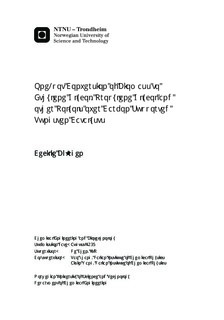One-pot Conversion of Biomass to Ethylene Glycol, Propylene Glycol and other Polyols over Carbon Supported Tungsten Catalysts
Master thesis
Permanent lenke
http://hdl.handle.net/11250/247933Utgivelsesdato
2013Metadata
Vis full innførselSamlinger
- Institutt for kjemi [1394]
Sammendrag
Tungsten carbide and nickel promoted tungsten oxide catalysts supported on CNTs and AC were prepared for the catalytic conversion of cellulose towards polyols, particularly EG. Incipient wetness impregnation was used for the synthesis of tungsten oxide and tungsten carbide catalysts with AC as support, while the Pechini method was used with both supports. It was found that the choice of a suitable loading method was influenced by the physical structure of the carbon support. AC, being a microporous material, was best coated by incipient wetness impregnation, whereas the mesoporous structure of CNTs allowed the larger metal complexes formed by the Pechini method to enter the pores, giving better dispersion of metal particles. The catalysts were characterised by BET, TGA, ICP, Chemisorption, S(T)EM, XRD and Raman. Both TGA and ICP analysis showed that the CNT support might contain trace metals, such as nickel from the CNT synthesis. This nickel content is most likely the reason for better EG yields with CNT based catalysts, and is also the reason for generally better yields by the nickel promoted tungsten oxide catalysts. The conversion tests were performed in a stainless-steel autoclave at a hydrogen pressure of 60 bar (increased to 130 bar during heating) and 245 °C. Among the catalysts tested, a CNT supported tungsten carbide catalysts, 20WCx/CNT, had the best catalytic activity, giving a total yield of 85 % and the second highest EG yield of 53.8 %. This is an exceptionally good result considering no promotion of nickel had intentionally been made. The highest EG yield (63.8 %) was obtained with an AC supported, nickel promoted tungsten oxide catalyst made by the Pechini method, 2Ni20WO3/AC-p. Reusability tests showed that the EG yield is significantly reduced in the second run and this problem must be overcome if these catalysts are to be an option in the conversion of cellulose. ICP results showed that leaching occurred during the reusability tests, both of tungsten and nickel. The CNT based carbide catalyst displayed a lower nickel leaching in first run compared to the tungsten oxide catalyst, which might have contributed to the slightly superior performance in the second run.
